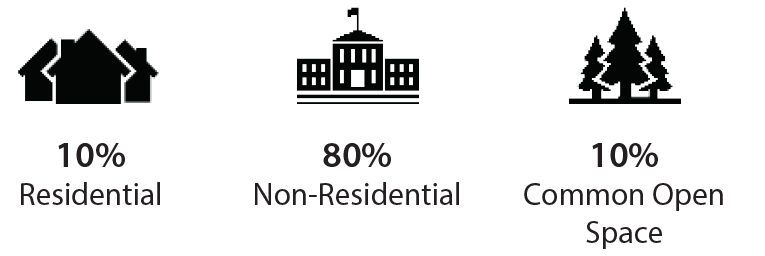Place Types - Business
Place Types - Business
Place Types are a classification of land that provides guidance for how future development should look and function. They describe types and intensities of land use as well as important characteristics such as scale, site design, and accessibility. These draft policies will be reviewed by staff and the community, with a final draft document anticipated in Fall 2018. You are reviewing Business, one of 14 different Place Types. Thank you for your time and interest in shaping the future of our community.
DRAFT Document - Business
Click this link to open a full copy of Place Types - Business
You'll need this for reference as you take the survey.
Summary
(Sidebar on right side of document)
This section summarizes the intent and rataionale for the "building blocks" of Place Types. These "building blocks" range from Land Use to Transportation.
Please share any questions/comments you have on the following "building blocks".
Goals
- Serve the needs of those traveling along major streets and near interchanges.
- Focus these places at critical locations that are not otherwise identified as pedestrian oriented environments.
- Encourage some existing Business areas to redevelop and be integrated with other Place Types in the future, thereby reducing the area this place makes up throughout the City.
Land Use
- Business is made up of primarily retail and small office uses.
- Hotels and larger offices may also be located at interstate interchanges.
Urban Design
- Buildings in Business are typically low rise.
- Sites are primarily designed to accommodate automobile traffic, but should be sensitive to other modes of transportation as well.
Transportation
- Business is typically located along Arterial Streets and near interstate interchanges.
- Although specific land uses on these streets may be pedestrian-oriented, auto-oriented or somewhere in between, streets should accommodate travel by a variety of modes.
Elements
(Items starting at lower left corner of document, eg. Typical Mix of Land Uses)
This section further refines the "building blocks" mentioned in the summary. These city-building characteristics range from Building Size to Sidewalks and vary from Place Type to Place Type.
Typical Mix of Uses
Zoning Districts
- This Place Type will have multiple zoning districts that allow for the development of non-residential development along major streets. Other zoning districts will provide guidance for those sites located at interstate interchanges and other major interchanges.
- Specific Zoning Districts will be developed for this Place Type - TBD
Building Types
- In most cases, buildings are single-use or small strip centers however mixed use buildings may also be appropriate if they can provide appropriate transitions to adjacent places and have accessibility to a major street.
- The predominant building type is a low-rise commercial building.
- Sites frequently include drive through facilities and gas pumps and they should be designed to safely accommodate pedestrians both within the site and those traveling from the sidewalk along the street.
- Mid-rise commercial buildings may be appropriate at interstate interchange areas.
Building Size
- Buildings in Business are typically between 2,000 and 20,000 square feet.
- Hotels and commercial buildings at interchanges may be larger if the site is within an interstate interchange area.
Building Length Along The Street Frontage
- Shorter building lengths provide a more interesting and comfortable pedestrian environment and allow for better block structure.
- Buildings should be less than 150 feet long along a block face.
Building Height
- Most buildings are single story in Business.
- Some buildings may be multi-storied if appropriate transition to surrounding places is provided.
- If located in an interchange area, buildings may be up to 5 stories, but most are between 1 and 3 stories.
Yards
- Not applicable.
Orientation
Note: Arterial Streets are higher volume streets (not freeways) that travel
to and through Places. The terms Main Street, Avenue, Boulevard, and
Parkway refer to the more specific design classifications (from the Urban
Street Design Guidelines) that refine the generic Arterial Streets into
context-based streets. Arterial Streets is used generically here, with USDG
classifications applied where necessary to make distinctions between
expected design and context. Local streets are lower-volume streets that
provide direct access to land uses off of Arterial Streets.
- Business is typically located along Arterial Streets, and also include Local Streets external or internal to the site.
- Business may orient to Boulevards, Avenues, and Local Streets. Business may be located adjacent to Parkways, but should not orient towards them.
- Buildings should be set back farther from Boulevards and some Avenues, but should still orient to and provide direct pedestrian access from the street onto the site and to principal buildings.
- Orientation to useable common open spaces is also encouraged.
- Buildings should not be oriented toward a driveway, interior parking lot, or alley.
Building Frontage Along Streets
- Business predominantly serves those traveling along major streets, but must be accessible by multiple modes from nearby neighborhoods and transit stops.
- Sites should be designed to provide direct Local Street connections and a safe, interesting public realm from nearby neighborhoods and transit stops, thereby encouraging walking, cycling, and transit use.
- Buildings should include operable entrances and significant transparency along street frontages, particularly along Avenues and Local Office/Commercial Streets.
- Buildings set farther back from an Arterial Street (along Boulevards, e.g.) should still include clearly visible pedestrian connections and operable entrances from the Arterial Street at intervals no greater than 200 feet.
- Buildings on corner lots are encouraged to have entrances that front on both streets or provide an entrance from the corner of the building. Entrances should be aligned with existing or future planned pedestrian facilities where feasible.
- Parking (other than on-street parking) should typically not be located between the building and street. If minimal parking is included between buildings and streets (e.g. Boulevards), there should direct access from the street and sidewalk through the parking to the building entrance and buildings should still provide a presence along the street by orienting toward them.
- Street frontages should be substantially built out, with minimal driveways/curb cuts, to maintain a good pedestrian environment and public realm (I2). Sidewalks along driveways are encouraged to allow for clear pedestrian access onto the site.
Building Coverage and Impervious Surface
- Impervious surfaces typically make up 75% of development within a Business site.
- Building coverage is typically up to 20% of the site.
- Impervious surfaces may be made up of buildings, driveways, streets, parking, plazas, and buildings.
- Approximately 25% of the land in a Business site is pervious. Preferably, these areas are grassed or landscaped.
- Pervious areas should accommodate trees that contribute to the city’s tree canopy.
Connectivity
- Business is typically located along an Arterial Street or near intersection interchanges.
- Local Street networks and connections to Arterial Streets are critical to support activity throughout the Sector.
- Block lengths are preferably no greater than 500’, and should be closer to 400’, particularly if the Business Place Type is adjacent to a Transit Station Area.
Pedestrian Network
- There should be clear and visible on-site sidewalk connections from streets directly to buildings.
Parking
- Surface parking is typical for Business sites.
- Parking is preferred to the side or rear of buildings with minimal parking between the building and the street to safely accommodate pedestrians from the public street.
- While not discouraged, structured parking is not typical for sites in Business.
- Parking lots should be designed and located to provide vehicular cross-access between streets.
- Parking lot entrances should be designed and located so that driveways align on either side of Local Streets.
Vehicular Access
- Most sites are accessed from Arterial Streets since they are typically located along major streets and near interstate interchanges.
- Driveways should be limited to maintain a high quality pedestrian environment. For the same reason, shared driveways and cross access are highly encouraged.
Streets
- Arterial Streets should be designed to allow safe and comfortable access for pedestrians, bicycles, and transit.
- Most Arterial Streets within Business will be classified as Avenues or Boulevards. In some cases Arterial Streets within Business sites may be classified as Parkways.
- Arterial Streets in Business areas may have less frequent traffic signal spacing than in denser Place Types. Therefore other crossing opportunities for pedestrian and bicyclists should be implemented in conjunction with key connections and destinations (like transit stops, side streets, parks/greenways, etc.).
- Target speeds should be low (preferably maximum 20-25 mph on internal streets; 35 mph on Arterial Streets).
Sidewalks
- Sidewalks should be wide enough to accommodate pedestrian volumes and maintain unobstructed walking space for people travelling to/from office and commercial uses and nearby neighborhoods.
- Business areas likely include fixed-service transit routes, therefore pedestrian facilities should allow safe and comfortable access for transit users.
- Internal Local Streets should have minimum 5’ wide unobstructed sidewalks.
- Arterial Streets should have minimum 6’ wide unobstructed sidewalks.
- There should be clear and visible on-site sidewalk connections from Arterial Streets directly to buildings and to the internal pedestrian network.
Green Zone
- The Green Zone is typically no less than 8’ wide to accommodate shade trees, grass, and/or hardscape elements. It provides separation between pedestrians and vehicles, helps calm traffic, provides an attractive public realm, contributes to the City’s healthy tree canopy, and shades the streets and users.
- A hardscape amenity zone is inappropriate in most Business areas. A grass planting strip with street trees is the typical treatment.
Bicycle Facilities
- Dedicated bike facilities are expected on Arterial Streets due to higher speeds and volumes.
- Shared lanes are used on internal streets, since speeds and traffic volumes should be low.
- Design of the bicycle facility varies (see general provisions, p. XX, for factors influencing bike facilities).
Street Furnishings
- Street furnishings should be located in the Green Zone or setback, not in the sidewalk.
- On internal streets, the Green Zone should include trees and, combined with a setback, should be wide enough for pedestrian lighting, and transit stops/facilities.
- All bus stops should be accessible from a sidewalk.

